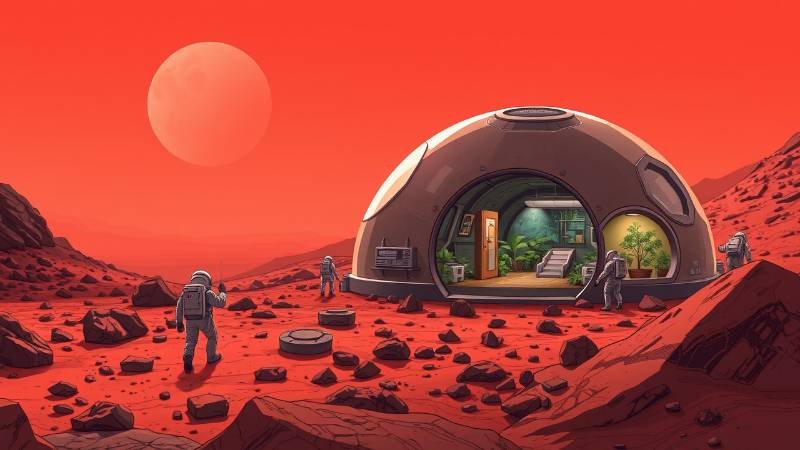Imagine stepping onto the rusty, red surface of Mars, gazing at a pinkish sky, and wondering if this alien world could ever be home. The question, Can humans live on Mars planet?, has captivated scientists, dreamers, and space enthusiasts for decades. Mars, with its harsh environment and distant location, presents daunting challenges but also sparks hope for humanity’s future beyond Earth. In this article, we’ll dive into the possibilities, obstacles, and innovations that could make living on Mars a reality.
Why Mars? The Appeal of the Red Planet
A Planet with Potential
Mars is often called Earth’s cousin because of its similarities, like a 24.6-hour day and evidence of ancient water flows. These factors make it a prime candidate for human exploration and potential colonization. Scientists believe Mars once had rivers and lakes, hinting at a past that might have supported life.
The Dream of a Second Home
As Earth faces overpopulation and climate challenges, Mars offers a backup plan for humanity. Visionaries like Elon Musk and organizations like NASA aim to establish a human presence on Mars, turning science fiction into reality. But how feasible is it to live on the Red Planet?
Challenges of Living on Mars
Harsh Environmental Conditions
Mars is no paradise. Its thin atmosphere, composed mostly of carbon dioxide, offers little protection from cosmic radiation. Temperatures average around -80°F (-62°C), with extreme swings that test human endurance. The low air pressure also makes liquid water scarce, complicating survival.
Lack of Breathable Air
Humans need oxygen to survive, but Mars’ atmosphere is only 0.13% oxygen compared to Earth’s 21%. Creating a breathable environment would require advanced life support systems or terraforming—a process to transform Mars’ atmosphere, which could take centuries.
Food and Water Scarcity
Growing food on Mars is a significant hurdle. The soil, rich in toxic perchlorates, isn’t suitable for traditional farming. Hydroponics or genetically modified crops could be solutions, but they require substantial resources. Water exists as ice, but extracting and purifying it demands energy and infrastructure.
Technological Solutions for Mars Colonization
Habitats for Human Survival
To live on Mars, humans would need shielded habitats to protect against radiation and extreme conditions. Inflatable modules, underground bases, or 3D-printed shelters using Martian soil are being explored. NASA’s Mars Habitat Challenge encourages innovative designs for sustainable living spaces.
Life Support Systems
Closed-loop life support systems, like those tested on the International Space Station, could recycle air, water, and waste. These systems are critical for long-term survival, reducing reliance on Earth resupply missions.
Energy and Resources
Solar panels could harness Mars’ sunlight, though dust storms pose challenges. Nuclear reactors are another option for reliable power. Mining local resources, like water ice for drinking and fuel, is also key to self-sufficiency.

The Role of Terraforming in Making Mars
What is Terraforming?
Terraforming involves altering Mars’ environment to make it more Earth-like. This could mean releasing greenhouse gases to warm the planet or creating an artificial magnetic field to shield the atmosphere. While theoretically possible, terraforming is a long-term, energy-intensive process with uncertain outcomes.
Current Research and Experiments
Scientists are studying ways to make Mars habitable. For example, experiments with microorganisms show some could survive Martian conditions, potentially aiding in creating sustainable ecosystems. However, these are early steps, and full terraforming remains a distant goal.
Psychological and Social Challenges
Isolation and Mental Health
Living on Mars would mean isolation from Earth, with communication delays of up to 20 minutes. Astronauts would face psychological stress from confined spaces and limited social interaction. Training for mental resilience, as seen in NASA’s HI-SEAS missions, is critical.
Building a Community
A Martian colony would need a diverse group of skilled individuals to form a functional society. Education, governance, and recreation systems would be essential to maintain morale and cooperation in such an extreme environment.
Current Missions and Future Plans
Ongoing Exploration
Missions like NASA’s Perseverance rover and China’s Tianwen-1 are studying Mars’ surface for signs of past life and resources. These missions provide data crucial for planning human settlements.
Future Human Missions
SpaceX aims to send humans to Mars by the late 2020s, while NASA targets the 2030s. These missions will test technologies and gather data to make long-term habitation possible. For more on upcoming missions, check NASA’s Mars Exploration Program.
Conclusion
So, can humans live on Mars planet? The answer is a cautious yes, but it’s not simple. Overcoming environmental, technological, and psychological challenges requires innovation, collaboration, and time. While we’re not packing our bags for Mars yet, ongoing research and missions bring us closer to that dream. Curious to learn more? Explore related articles on Space.com or follow updates from space agencies to stay in the loop on humanity’s journey to the Red Planet.
FAQs
How long would it take to travel to Mars?
A trip to Mars takes about six to nine months, depending on the spacecraft and planetary alignment.
Can we grow food on Mars?
Yes, but it requires advanced techniques like hydroponics, as Martian soil contains toxic perchlorates.
Is there water on Mars?
Mars has water in the form of ice, primarily at its poles and underground, which could be extracted for use.
How would humans breathe on Mars?
Humans would need sealed habitats with oxygen-generating systems or rely on regular supply missions from Earth.
When will humans live on Mars?
Optimistic timelines suggest human missions in the late 2020s or 2030s, with permanent settlements likely decades later.




